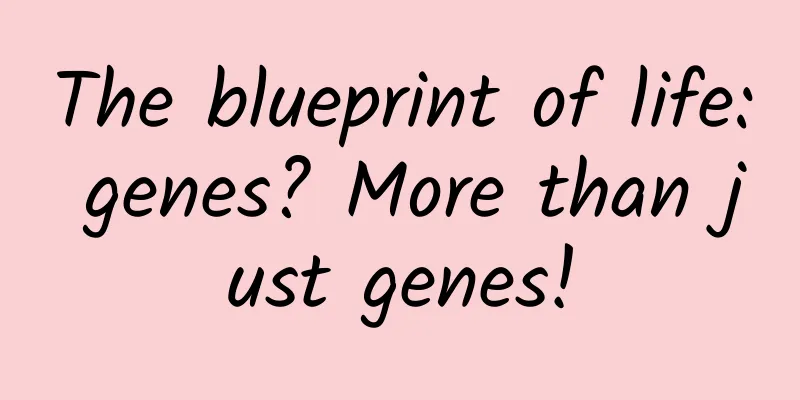The blueprint of life: genes? More than just genes!

|
The winning works of the 2023 "China Science Popularization Star Creation Competition" Author: Yin Tao, Zheng Liyao Gene, heredity, DNA... I don't know since when, these words, which were originally professional terms in the fields of genetics and life sciences, have frequently appeared in people's daily conversations. But do you know what the relationship between DNA and genes is? What exactly are we talking about when we talk about heredity? This is the underlying logic behind every moment and every move of you and me. Without the sophisticated genetic mechanism, life would never have evolved into what it is today. From blueprints to “just blueprints” --From DNA to Genes-- In 1953, James Watson and Francis Crick published an article in the journal Nature proposing the double helix structure model of DNA, which was an important milestone in human understanding of the genetic mechanism. Of course, there were also contributions from Rosalind Franklin and Maurice Wilkins, whose early research provided key data for this subtle answer. In order to help the public quickly and intuitively understand the structure of DNA, scientists use many everyday objects to describe it. For example, the DNA molecule is described as a "rope ladder", where each "rung" represents a pair of bases paired according to specific rules. This wonderful metaphor has some omissions in the process of information simplification, resulting in information loss. Compared to a rope ladder, the DNA molecule is actually more like a zipper, and the paired bases are like zipper buckles that bite into each other; by the way, this zipper has to be held from both ends and twisted several times to more accurately simulate the spiral structure of the DNA molecule. So, what are genes? Genes are the basic units of heredity, usually a sequence of nucleotides that encodes one or more specific proteins. (Please note that the information here is simplified and not rigorous enough.) As for nucleotides, they refer to the basic building blocks of DNA or RNA molecules, which are deoxyribonucleotides in DNA molecules and ribonucleotides in RNA molecules. Multiple nucleotides are polymerized into nucleic acids. Does the word "nucleic acid" sound familiar to you? That's right, in the past few years, we have often talked about "doing nucleic acid", which refers to the nucleotide sequence of DNA or RNA molecules for testing viruses, referred to as nucleic acid testing. -- Genome: Much More Than Genes -- In people's general understanding, genes composed of DNA draw the "blueprint" of life; the DNA sequence corresponding to the gene is a set of mysterious "genetic codes", in which all the mysteries of life are hidden. To explain this clearly, we also need to have a brief understanding of chromosomes and genomes. Chromosomes are important carriers of genetic material and can be seen as "small packages" composed of DNA and protein. In 1956, Chinese-American geneticist Jiang Youxing, who worked at the Institute of Genetics at Lund University in Sweden, published a paper stating that there are 46 chromosomes in human somatic cells. (Before that, American doctor and cytogeneticist Theophilus Painter concluded that there are 48 chromosomes.) This was the beginning of human cytogenetics. A normal human cell has 23 pairs of chromosomes, and genes are fragments on chromosomes, which are scattered around, close or far from each other. Each gene is composed of a DNA sequence that is either long or short. You probably know that there are only four letters in the "code book" of DNA, which can be represented by ATGC (including its "close relative" and "partner" RNA, there are only five letters, just replace T with U in the RNA molecule), corresponding to the four bases in the DNA molecular structure. And the pairing of these letters is very specific. In most cases, A only recognizes T (U), and C only pairs with G. Sounds too simple to be true, right? Even more so when you consider that this is essentially the same genetic code that all living things share! Can such a complex and diverse life really be determined by such a simple mechanism? Let’s start from the beginning: DNA makes up genes, right? So, does all DNA make up genes? Of course not. I see! So, we need to answer two questions: one is how big the difference in the number of genes is between different species; the other is what proportion of DNA makes up the genes. Here we need to first mention the concept of genome, which includes all the genetic information required for the development of a species. For humans, it can be simply considered as the information carried by the DNA sequences on all chromosomes (this is also a simplification). Please note that the scope of the genome is larger than that of genes, in fact much larger. Humans have only about 20,000 genes. When the 3-billion-base-pair draft of the human genome was released in 2001, people were shocked because the number of 20,000 was far from the 100,000 genes that scientists had predicted. In other words, humans have about the same number of genes as mice commonly used in laboratories, and not much more than worms. As for the proportion of DNA that constitutes genes, it is only 2% of all human DNA sequences! In other words, 98% of the DNA sequences in the human genome do not constitute genes. --The importance of "useless DNA"-- In fact, it is not difficult to understand that "useless DNA" has complex and important functions. Just imagine that humans have abilities far superior to mice and are much more complex than worms, but the number of genes in these three species is not much different; and a considerable part of human genes can be found in the genomes of other organisms. "Distant relatives" with similar functions, then it should make sense that "useless DNA" that accounts for 98% of the human genome is very important, right? Image source: Nisha Carey's "Invisible Genetic Code", CITIC Publishing Group April 2023 edition However, this is only our hindsight. The scientists who discovered these genomic "dark matter" must have been very disappointed at the time, because they named the DNA outside of these genes "Junk DNA", which translates to "junk DNA" or "useless DNA", which shows their disappointment and confusion. At that time, people felt that the precious genes seemed to live in a garbage dump, and the remaining DNA sequences seemed to be just the "nonsense" of the genome, "garbled code" written in base pairs, and had no practical function. For a long time, "useless DNA" has been forgotten in the corner of genetic research, and no one paid attention to it until some abnormal genetic cases reminded scientists to re-understand them. For example, there is a dominant genetic disease commonly known as "Peter Pan disease" (Facioscapulohumeral muscular dystrophy, abbreviated as "FSHD"), and scientists have not been able to find the corresponding disease-causing gene. This disease is not uncommon in Western populations, with an incidence rate of about 1/20,000. It makes people unable to smile normally, and it will cause the patient's shoulder blades and other parts to deform, looking like two small wings. The characteristic of dominant genetic diseases is that at least one of the patient's parents must be sick, so to some extent it should be easier to find the disease-causing gene. Scientists did find an extremely long repetitive sequence on the patient's chromosome 4, but strangely, this is not the place where the gene lives. You must have guessed it, this is the "useless DNA" sequence that is regarded as garbage. Further research shows that what is crucial is the number of repetitions of a "useless DNA" sequence. We won’t go into the intricate details of the research. Although the clinical symptoms of FSHD patients were described by French neurologists as early as 1885, and the rapid development of genetics and cellular research techniques have made great progress in our understanding of the disease, a study published in the journal Science in 2010 pointed out that the underlying genetic mechanism of the disease remains elusive. Genes are indeed a blueprint, but they are only a blueprint. Blueprint implementation, gene expression Our life begins with a cell (fertilized egg). Without considering special circumstances, every cell in the body has the same DNA sequence. Despite this, only a part of the genes in each cell are functional. This is not difficult to understand. The genes that work in your brain cells and muscle cells are definitely different. The genetic code recorded in the DNA sequence of the gene will be transmitted and translated by a messenger molecule called RNA into a protein with a different amino acid sequence to function. This process is called gene expression . If it cannot be expressed, even the most sophisticated genetic code is useless. It took scientists decades to realize that the "useless DNA" that was once regarded as garbage actually plays an important role in the gene expression process. Some "useless DNA" fragments are gene switches that can determine whether the gene works; some "useless DNA" fragments play a modifying role. How much of the original meaning of the "sentence" written by a gene related to a certain function or a certain feature can be expressed depends on them. When each cell in the body reads the genetic code stored in the DNA sequence, the "useless DNA" plays a different role due to the different environments in which the cells are located, affecting the expression of genes, and the same script derives different performances in different scenarios. This is the research scope of a new science called epigenetics . --From Telomeres to Pan-Genomes-- If we ask whether a person's success is determined by nature or nurture, different people will give different answers, but there should be quite a few people who agree with the answer of "nature + nurture". The situation is similar for each of our cells. You may have heard of the word "telomere", which is a kind of "useless DNA". If each chromosome is regarded as a shoelace, the telomere is like the metal plug at the end of the shoelace, which will wear out as the years go by. Once the metal is worn out, the shoelace will fall apart and it will be difficult to insert it into the hole; and the wear of the telomere means that the life is weakening. So, what factors are related to the health of telomeres? The answer is the interaction between innate genetics and acquired lifestyle. Everyone's genes affect the length of telomeres at birth and its wear rate; what food you eat, how you sleep every day, how much exercise you have, whether you are in a good mood, whether you have a stable emotional connection with the people around you... Any interaction between you and the outside world will have a greater or lesser impact on your telomeres. In their co-authored book Telomeres, Elizabeth Blackburn, winner of the 2009 Nobel Prize in Physiology or Medicine, and Eliza Ipal, director of the Center for Aging, Metabolism, and Mood at the University of California, San Francisco, wrote: "Genes load the gun, and the environment pulls the trigger." This is also an apt metaphor, especially when it comes to health and disease. In May 2023, the first draft of the human "pan-genome" was published in the journal Nature. Twenty years after the first human genome map was published, the pan-genome incorporates the genetic diversity brought by different regions and races. We have reason to believe that epigenetics has made a considerable contribution to this. The next time you see a baby miraculously developing unique skills at different stages of growth, being able to recognize people, stumbling to walk, and babbling, don't just sigh that life has its own built-in program. After all, different babies develop the same skills earlier or later; they are developing their own unique personalities step by step, and each child will be unique. When we talk about the blueprint of life, please think more about it. It's not just genetic factors. Your lifestyle, your environment, and your interactions with the people around you are also crucial in determining what kind of work this blueprint can create. References: 1. Nisha Carey: The Invisible Genetic Code, translated by Zhu Jinjie, CITIC Publishing Group, 2023. 2. Cobb M, Comfort N. What Rosalind Franklin truly contributed to the discovery of DNA's structure. Nature. 2023 Apr;616(7958):657-660. doi: 10.1038/d41586-023-01313-5. 3. Lemmers RJ, van der Vliet PJ, Klooster R, et al. A unifying genetic model for facioscapulohumeral muscular dystrophy. Science. 2010, 329(5999):1650-1653. 4. Zhang Cheng, Li Huan. Research progress of facioscapulohumeral muscular dystrophy[J]. Chinese Journal of Modern Neurological Diseases, 2019 19(5):13. 5. Elizabeth Blackburn and Eliza Ipal: Telomeres, translated by Fu He, Hunan Science and Technology Press, 2021. 6. Liao WW, Asri M, Ebler J, et al. A draft human pangenome reference. Nature. 2023, May;617(7960):312-324. doi: 10.1038/s41586-023-05896-x. Epub 2023 May 10. |
>>: Jinyun palm-tipped toad! A new amphibian species discovered in Chongqing
Recommend
Not only does it turn blue, there are new changes. Have you used these "new features" of Alipay?
[[319367]] Not long ago, "Alipay has turned ...
You can quickly restore your energy in 10 minutes, and you can do it anytime and anywhere. If you don’t know this method, you will miss out.
If I don't take a nap, I'm afraid I'l...
GAC's graphene battery has a range of 1,000 kilometers? Industry experts: Still need market testing
Recently, GAC Aion announced that its graphene te...
University of Maryland School of Medicine: Study finds more than 70% of doctors still prescribe unsafe antibiotics
A study of primary care physicians found that bas...
Foreign media: If you are still using an older model, it is worth upgrading to iPhone 13
According to foreign media macrumors, comparing t...
How much does it cost to produce the Zhangjiajie Driving School mini program? Zhangjiajie Driving School Mini Program Production Price Inquiry
How much is the quotation for Zhangjiajie Driving...
China Automobile Dealers Association: Analysis of China's imported automobile market in April 2022
(I) Supply: After three years of decline, automob...
There are 100 ways to gain followers on WeChat. Which ones have you learned?
People often ask me how to add people. Here is a ...
When traveling long distances, beware of "economy class syndrome"!
Author: Kan Shifeng, deputy chief physician, Firs...
Super practical "The detours you must not take when making Douyin" The trader instructor teaches you the dry goods without reservation
Super practical! Don't take the detours when ...
How to plan website activities in November, the peak season for e-commerce?
If someone asked you how to increase sales of an ...
Congratulations! my country successfully launched the test satellite No. 20C
At 9:01 am on October 29, my country successfully...
7 aspects that a complete operation plan should include
Operations are basically a process of constantly ...
Apple wants to make the iPad your primary work device
For a long time, people seemed to have not found ...
How far can a taxi-hailing app that has forgotten its original purpose go?
Frankly speaking, I am a loyal user of taxi-haili...









